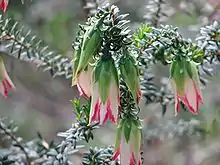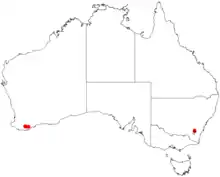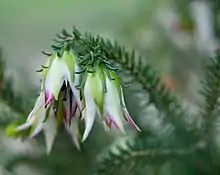Darwinia meeboldii
Darwinia meeboldii, the Cranbrook bell, is a shrub which is endemic to the south-west of Western Australia.[2] It has an erect and straggly habit, growing to between 0.5 and 3 metres high.[2] The bracts around the flowers form a pendent "bell" which is usually white with red tips.[3] A group of 8 small flowers are concealed inside. These are primarily produced between August and November.[2][3]
| Darwinia meeboldii | |
|---|---|
 | |
| Scientific classification | |
| Kingdom: | Plantae |
| Clade: | Tracheophytes |
| Clade: | Angiosperms |
| Clade: | Eudicots |
| Clade: | Rosids |
| Order: | Myrtales |
| Family: | Myrtaceae |
| Genus: | Darwinia |
| Species: | D. meeboldii |
| Binomial name | |
| Darwinia meeboldii | |
 | |
| Occurrence data from AVH | |

It occurs on peaty soils on slopes in the western part of the Stirling Range National Park.[2][4]
Use in horticulture
The species requires good drainage and protection from direct sun.[3] It is difficult to propagate from seed, but cuttings strike readily.[3] Grafting on stocks of Darwinia citriodora may be carried out in areas with unsuitable growing conditions including high humidity.[3]
References
- "Darwinia meeboldii". Australian Plant Name Index (APNI), IBIS database. Centre for Plant Biodiversity Research, Australian Government, Canberra. Retrieved 23 July 2009.
- "Darwinia meeboldii". FloraBase. Western Australian Government Department of Parks and Wildlife.
- "Darwinia meeboldii". Australian Native Plants Society (Australia). Retrieved 17 September 2019.
- "Approved Conservation Advice for Darwinia meeboldii (Cranbrook Bell)" (PDF). Department of the Environment, Water, Heritage and the Arts. 2008. Retrieved 24 July 2009.